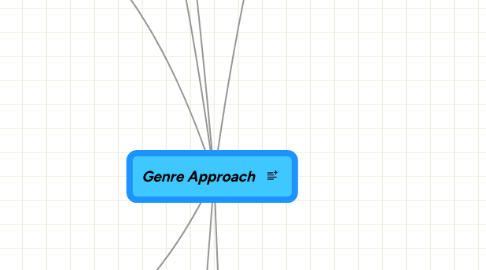
1. Advantages
1.1. Explicit
1.1.1. understand how and why target texts are structured
1.1.2. makes clear what is to be learned
1.1.3. gives students a structure, rather than relying on hit and misses of inductive approach
1.2. Systematic
1.2.1. addresses texts and contexts
1.2.2. know the social purposes of the texts
1.2.3. link the text to their purpose, audience and message
1.3. Needs-based
1.3.1. stresses on specific culture or familiar real-life contexts
1.3.1.1. offers students an explicit understanding of how texts are structured
1.4. Supportive
1.4.1. teacher scaffolds or support learners
1.4.1.1. interactive collaboration
1.5. Empowering
1.5.1. allows them to approach writing with ease and confidence and help them gain entry in certain communities
1.6. Critical
1.6.1. reflect and critique on how language and information are organized in texts
1.7. Consciousness raising
1.7.1. increases teacher awareness of texts to confidently teach writing
2. as a social response to the process approach
2.1. explains WHY behind writers' language choices
2.2. process approach not exactly useful for ESL learners because process relies very much on shared contextual knowledge
2.3. genre approach explains HOW social context affects linguistic choices and outcomes
2.4. helps to unite the social and cognitive because they are central to how writers understand, conduct and reproduce their social realities
2.5. teaching of key genres help learners gain access to ways of communicating that have accrued social or cultural capital in different communities
2.6. as a SOCIAL PRACTICE
3. Goal
3.1. Using scaffolding and knowledge of language to guide both L1 and L2 learners (especially) towards consciously understanding target genres and the way language creates meaning in context
4. Characteristics
4.1. planned around themes that are real life experiences so that students can draw upon their personal experiences and prior knowledge
4.2. Scaffolding
4.2.1. takes many forms but typically includes modeling of text, explicit instruction and teacher input
4.3. Grammar
4.3.1. Genre teaching involves being explicit a about how test are grammatically patterned, but it is not taught as a discrete component. Rather, it is integrated into the exploration of text and context
4.4. teaching gives importance to collaborative methods
5. Counter Arguments
5.1. deciding what is being taught is not neutral
5.1.1. involves some level of authority in decision making with important consequences
5.2. Stifles creativity
5.2.1. inhibits writers' creativity and self-expression
5.2.2. danger of precriptivism
5.2.3. reproductive element
5.2.4. restrictive formula
6. Functional approach to language teaching
6.1. factors affecting language features
6.1.1. genre
6.1.1.1. ways people make meaning with one another in stages to achieve their purpose
6.1.2. register
6.1.2.1. Field: content
6.1.2.2. Tenor: relationship between writer and audience
6.1.2.3. Mode: how language is organized
6.2. Curriculum cycle
6.2.1. 1. Negotiating field
6.2.1.1. Establish content
6.2.1.2. build on current understanding
6.2.2. 2. Deconstruction
6.2.2.1. discussing purpose of genre/register
6.2.2.2. investigate text to determine stages/language features
6.2.3. 3. Joint construction
6.2.3.1. "shared writing"
6.2.3.1.1. teacher & student creating a written text together
6.2.3.1.2. scaffold, provide guiding questions
6.2.3.2. joint construction session
6.2.3.2.1. genre review (revision)
6.2.3.2.2. task orientation (explanation)
6.2.3.2.3. negotiation (scaffolding)
6.2.3.2.4. conclusion (reading)
6.2.3.3. Criteria for successful joint construction
6.2.3.3.1. sufficient knowledge of genre
6.2.3.3.2. Language used (grammar)
6.2.3.3.3. keep session focused on scaffolding the genre
6.2.3.3.4. aware of effective forms of interaction
6.2.3.4. effective in teaching children how to write
6.2.3.4.1. involves contextualizing the writing process in terms of genre
6.2.3.4.2. practice of scaffolding
6.2.3.4.3. explicit in interaction with learners
6.2.4. 4. independent construction of text
6.2.4.1. teachers need to be aware of when individual children are ready to undertake their own writing
7. Hyland's Rebuttals
7.1. Stifles creativity--> Yes, genre approach does have a constraining power
7.1.1. BUT! our choices are made in a context of powerful incentives where choices have communicative and social consequences
